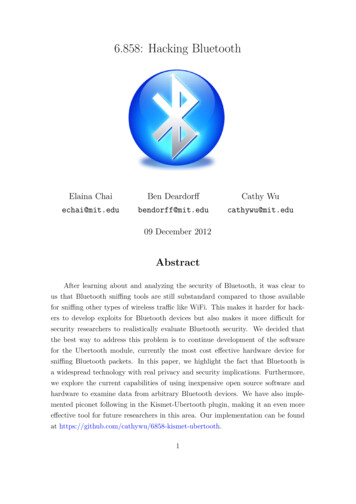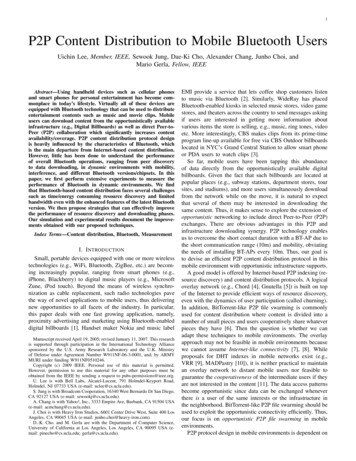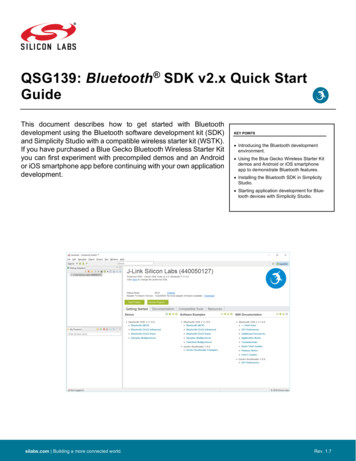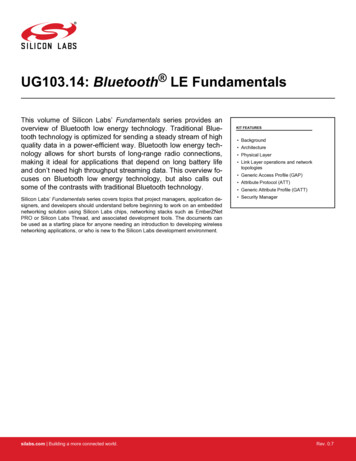
Transcription
UG103.14: Bluetooth LE FundamentalsThis volume of Silicon Labs’ Fundamentals series provides anoverview of Bluetooth low energy technology. Traditional Bluetooth technology is optimized for sending a steady stream of highquality data in a power-efficient way. Bluetooth low energy technology allows for short bursts of long-range radio connections,making it ideal for applications that depend on long battery lifeand don’t need high throughput streaming data. This overview focuses on Bluetooth low energy technology, but also calls outsome of the contrasts with traditional Bluetooth technology.Silicon Labs’ Fundamentals series covers topics that project managers, application designers, and developers should understand before beginning to work on an embeddednetworking solution using Silicon Labs chips, networking stacks such as EmberZNetPRO or Silicon Labs Thread, and associated development tools. The documents canbe used as a starting place for anyone needing an introduction to developing wirelessnetworking applications, or who is new to the Silicon Labs development environment.silabs.com Building a more connected world.KIT FEATURES Background Architecture Physical Layer Link Layer operations and networktopologies Generic Access Profile (GAP) Attribute Protocol (ATT) Generic Attribute Profile (GATT) Security ManagerRev. 0.7
UG103.14: Bluetooth LE FundamentalsBackground1. BackgroundSilicon Labs is developing products designed to meet the demands of customers as we move to an ever-connected world of devices inthe home, what is often referred to as the IoT (Internet of Things). At a high level, the goals of IoT for Silicon Labs are to: Connect all the devices in the home with best-in-class networking, whether with Zigbee PRO, Thread, Bluetooth low energy technology, or other emerging standards. Leverage the company’s expertise in energy-friendly microcontrollers. Enhance established low-power, mixed-signal chips. Provide low-cost bridging to existing Ethernet and Wi-Fi devices. Enable cloud services and connectivity to smartphones and tablets that promote ease of use and a common user experience forcustomers.Achieving all of these goals will increase adoption rates and user acceptance for IoT devices in the Connected Home.Bluetooth technology is a core component of the IoT. Bluetooth was designed to offer a wireless alternative to cable connections byexchanging data using radio transmissions. One of the most popular applications for Bluetooth has been wireless audio. This uses aversion of Bluetooth called BR/EDR (Bit Rate/Enhanced Data Rate) that is optimized for sending a steady stream of high quality data ina power-efficient way.Bluetooth version 4.0 introduced Bluetooth with low energy functionality. Developers are now able to create sensors that can run oncoin-cell batteries for months and even years. Some of these sensors are so efficient that the kinetic energy from flipping a switch canprovide operating power. Bluetooth low energy technology is inherently different from BR/EDR. BR/EDR establishes a relatively shortrange, continuous wireless connection, which makes it ideal for uses such as streaming audio from a smartphone to a headset. Bluetooth low energy technology allows for short bursts of long-range radio connections, making it ideal for IoT applications that depend onlong battery life. Furthermore, Bluetooth low energy technology is built on an entirely new development framework using GATT (Generic Attributes). GATT profiles describes a use case, roles, and general behaviors based on the GATT functionality. These profiles allowdevelopers to quickly and easily develop applications to connect devices directly to applications running on smartphones, PCs, or tablets.Bluetooth devices can be either dual mode, supporting both BR/EDR and Bluetooth low energy technology, or single mode, supportingBluetooth low energy technology only.As well as ultra-low power and connectivity to smartphones, PCs, and tablets, other benefits of Bluetooth low energy technology include: Low cost Reliable and robust: AFH (Adaptive Frequency Hopping), retransmissions and 24-bit CRC (Cyclic Redundancy Checks) Secure: pairing, bonding, privacy, MITM (Man in the Middle) protection, and AES-128 encryption Supports rapid development: Standardized profiles to cover key use cases (HR, HID, Glucose, Proximity, etc.) Profiles can be developed as applications, supporting fast deployment Vendor-specific profiles omit the need to wait for Bluetooth SIG to standardize profiles and operating system developers to integrate them Widely deployable: Supported by major platforms - iOS, Android 4.3 and newer, Windows 8 and 10, OSX, and LinuxThe Bluetooth specification is managed by the Bluetooth SIG (special interest group). The SIG maintains a website (https://www.bluetooth.com) that contains both introductory information and links to specifications and other more technical details. In this document, revisions of the specification are referred to parenthetically, where (BT5.0) means version 5.0 of the specification.This document provides an overview of the following aspects of Bluetooth low energy: Bluetooth architecture overview Radio features Basic of link layer Explanation of how device discovery and connections work Bluetooth security overview The Attribute Protocol The Generic Attribute Profile (GATT) and Bluetooth profilessilabs.com Building a more connected world.Rev. 0.7 2
UG103.14: Bluetooth LE FundamentalsBluetooth Low Energy Architecture2. Bluetooth Low Energy ArchitectureThe Bluetooth low energy architecture is illustrated in the following figure:Figure 2.1. Bluetooth Low Energy ArchitectureThe components are as follows: Physical layer: Controls radio transmission/receiving. Link Layer: Defines packet structure, includes the state machine and radio control, and provides link layer-level encryption.These two layers are often grouped into a Controller, with the remaining layers grouped into a host. A Host-to-Controller interface (HCI)standardizes communication between the controller and the host. The host layers are: L2CAP: Logical Link Control and Adaptation Protocol. L2CAP acts as a protocol multiplexer and handles segmentation and reassembly of packets. It also provides logical channels, which are multiplexed over one or more logical links. The L2CAP used in Bluetooth low energy technology is an optimized and simplified protocol based on the classic Bluetooth L2CAP. Typically, applicationdevelopers do not need to care about the details of interacting with the L2CAP layer. The interaction is handled by the Bluetoothstack, and the details of the L2CAP operation are not covered in this document. ATT: Attribute Protocol. The attribute protocol provides means to transmit data between Bluetooth low energy devices. It relies on aBluetooth low energy connection and provides procedures to read, write, indicate, and notify attribute values over that connection.ATT is used in most Bluetooth low energy applications and occasionally in BR/EDR applications. GATT: Generic Attribute Profile. The GATT is used to group individual attributes into logical services, for example the Heart RateService, which exposes the operation of a heart rate sensor. In addition to the actual data, the GATT also provides information aboutthe attributes, that is, how they can be accessed and what security level is needed. GAP: Generic Access Profile. The GAP layer provides means for Bluetooth low energy devices to advertise themselves or otherdevices, make device discovery, open and manage connections, and broadcast data. SM: Security Manager. Provides means for bonding devices, encrypting and decrypting data, and enabling device privacy.These components are discussed in more detail in the following sections.silabs.com Building a more connected world.Rev. 0.7 3
UG103.14: Bluetooth LE FundamentalsPhysical Layer3. Physical LayerBluetooth low energy operates in the 2.4 GHz ISM (Industrial Scientific Medical) band (2402 MHz - 2480 MHz), which is license-free inmost countries. The Bluetooth 4 specification defines 40 RF channels with 2 MHz channel spacing (see the following figure). Three ofthe 40 channels are advertising channels (shown in green), used for device discovery, connection establishment, and broadcast. Theadvertising channel frequencies are selected to minimize interference from IEEE 802.11 channels 1, 6 and 11, which are commonlyused in several countries.In the Bluetooth 5 specification, the three advertisement channels highlighted below are called the primary advertisement channels. The37 remaining channels are either used as secondary advertisement channels or data channels that can be used for additional advertisement data transmission.Figure 3.1. Bluetooth Low Energy Channels and FrequenciesData channels are used for bidirectional communication between connected devices. AFH (Adaptive FHSS) is used to select a datachannel for communication during a given time interval. AFH is reliable, robust, and adapts to interference.All physical channels use GFSK (Gaussian Frequency Shift Keying) modulation, with a modulation index of 0.5, which allows reducedpeak power consumption. In Bluetooth 4.0, 4.1, and 4.2 specification, the physical layer data rate is 1 Mbps.The Bluetooth 5 standard introduces an additional 2M PHY rate for faster throughput or shorter TX and RX times.The recent changes in the Bluetooth and regulatory standards allow Bluetooth Smart devices to transmit up to 100 mW (20 dBm) transmit power. However not all countries allow the 100 mW transmission power to be used because Bluetooth low energy radio can dropdown to two RF channels when there is significant interference.The requirements for a Bluetooth low energy radio are as follows:FeatureValueMinimum TX power0.01 mW (-20 dBm)Maximum TX power100 mW (20 dBm)Minimum RX sensitivity-70 dBm (BER 0.1%)The typical range for Bluetooth low energy radios is as follows:TX powerRX sensitivityAntenna gainRange0 dBm-92 dBm-5 dB160 meters10 dBm-92 dBm-5 dB295 metersThe range to a smart phone is typically 0-50 meters due to limited RF performance of the phones.silabs.com Building a more connected world.Rev. 0.7 4
UG103.14: Bluetooth LE FundamentalsLink Layer4. Link LayerThe Bluetooth low energy link layer provides the first level of control and data structure over the raw radio operations and bit streamtransmission and reception. For example, the link layer defines the following: Bluetooth state machine and state transitions Data and advertisement packet formats Link Layer operations Connections, packet timings, retransmissions Link layer level securityApplication developers do not need to understand these in detail, but some essential concepts affect the application design, development, and the end device operation. Summaries of these concepts are provided in this section.4.1 Link Layer OperationsThis section describes the basic Bluetooth low energy link layer operations, including: Advertising Scanning Connection establishment4.1.1 AdvertisementAdvertisement is one of the most fundamental operations in Bluetooth low energy wireless technology. Advertisement provides a wayfor devices to broadcast their presence, allow connections to be established, and optionally broadcast data like the list of supportedservices, or the device name and TX power level.The following figure illustrates a Bluetooth low energy device that is advertising broadcasts packets on one or multiple advertisementchannels, which remote devices can then pick up.Figure 4.1. Bluetooth Low Energy Advertisementsilabs.com Building a more connected world.Rev. 0.7 5
UG103.14: Bluetooth LE FundamentalsLink LayerThe application typically has control of the following advertisement parameters.Table 4.1. Advertisement ParametersParameterValuesDescriptionDefines the interval between the advertisementevents. Each event consist of 1 to 3 advertisementpackets depending on the configuration. A random0-10 ms is added by the link layer to every advertisement interval to help avoid packet collisions.Advertisement interval 20 ms to 10240 msAdvertisement channelsThe physical RF channels used to transmit the advertisement packets. For most reliable operation all chan37, 38 and 39 (primary channels); 0-10 and 11-36 (BTnels should be used, but reducing the number of5 secondary channels)channels used will reduce power consumption at thecost of reliability.Discoverability modeNot Discoverable; Generic Discoverable; Limited Discoverable; BroadcastDefines how the advertiser is visible to other devices.Connectability modeNot Connectable; Directed Connectable; UndirectedConnectableDefines if the advertiser can be connected or notPayload0 to 31 B (primary advertisement); 0 to 255 B (BT5secondary advertisement)0-31 bytes of data can be included in each primaryadvertisement packet. 0-255 bytes of data can be included in each secondary advertisement packet(Bluetooth 5)4.1.2 ScanningScanning is the operation where a scanner is listening for incoming advertisement in order to discover, discover and connect, or simplyto receive the data broadcast by the advertising devices.Two types of scanning modes are supported: passive scanning (Figure 4.2 Passive Scanning on page 6) and active scanning (Figure 4.3 Active Scanning on page 7).In passive scanning mode, the scanner simply listens for incoming advertisement packets. The scanner cycles through each advertisement channel in a round-robin fashion, listening to one channel at a time.Figure 4.2. Passive Scanningsilabs.com Building a more connected world.Rev. 0.7 6
UG103.14: Bluetooth LE FundamentalsLink LayerIn active scanning mode, the scanner listens for incoming advertisement packets and, upon receiving one, sends an additional scanrequest packet to the advertiser in order to learn more about it. Typically the scan response contains information like the list of supported services and friendly name, but the application has full control of the scan response data payload.Figure 4.3. Active ScanningThe application typically controls the following scan parameters.Table 4.2. Scan ParametersParameterValuesDescriptionScan interval2.5 ms to 10240 msThe interval is ms from the beginning of a scan eventto a beginning of a consecutive scan event. Must beequal or larger than scan window.Scan window2.5 ms to 10240 msThe scan window defines the duration of the listening(RX) window during a scan event.Scan typeLimited; Generic; ObservationDefines which type of advertisers the scanner reports.Scan modeActive; PassiveDefines if active or passive scanning is performed.Connectability modeNot Connectable; Directed ConnectableUndirected Connectablesilabs.com Building a more connected world.Defines if the advertiser can be connected to or not.Rev. 0.7 7
UG103.14: Bluetooth LE FundamentalsLink Layer4.1.3 ConnectionsConnections allow application data to be transmitted in a reliable and robust manner, as Bluetooth low energy connections use CRCs,acknowledgements, and retransmissions of lost data to ensure correct data delivery. In addition, the Bluetooth low energy connectionsuse Adaptive Frequency Hopping (AFH) to detect and adapt to the surrounding RF conditions and provide a reliable physical layer.Connections also support encryption and decryption of data to ensure its confidentiality.The Bluetooth low energy connection always starts by a scanner receiving an advertisement packet that includes the fact that the advertiser allows connections. The following figure illustrates how Bluetooth low energy connection establishment happens.Figure 4.4. Connection Establishment, Transmission of One Packet, and Connection TerminationThe application typically controls the following connection parameters.Table 4.3. Connection ParametersParameterValuesMinimum ConnectionInterval7.5 msDescriptionMinimum allowed connection intervalMaximum Connection4000 msIntervalMaximum allowed connection intervalConnection (peripher0 to 500 (connection intervals)al) latencyThe amount of connection events the peripheral is allowed to skip if it has no data to send.Supervision timeoutDefines how long the break in communications can be(for example due to out of range situation) before theconnection is dropped and an error is presented to theuser.100 ms to 32000 msThe connection parameters can be updated during the life time of a connection using a connection update message.The connection event (Figure 4.5 Connection Timeline on page 9) starts when the central device sends a packet to the peripheral atthe defined connection interval. The peripheral can respond 150 µs after it has received a packet from the central device. If the peripheral has no data to send, it can skip a certain number of connection events defined by the peripheral latency parameter (Figure4.5 Connection Timeline on page 9). If no packets are received by the central or peripheral device within the time defined by thesupervision timeout, the connection is terminated.silabs.com Building a more connected world.Rev. 0.7 8
UG103.14: Bluetooth LE FundamentalsLink LayerFigure 4.5. Connection TimelineFigure 4.6. Peripheral Latency (latency 3)If the peripheral has more data to send than can be fitted into a single packet, the connection event will automatically extend and theperipheral can send as many packets as there is time until the beginning of next connection interval. This can only be used with attribute protocol operations that do not require an acknowledgement.silabs.com Building a more connected world.Rev. 0.7 9
UG103.14: Bluetooth LE FundamentalsLink Layer4.2 Network TopologiesDevice roles in Bluetooth low energy technology are: Advertiser: A device that broadcasts advertisement packets, but is not able to receive them. It can allow or disallow connections. Scanner: A device that only listens for advertisements. It can connect to an advertiser. Peripheral: A device connected to a single central device (BT 4.0) or multiple central devices (BT 4.1 and newer). Central device: A device that is connected to one or more peripherals. Theoretically, a central device can have an unlimited numberof peripheral devices connected to it, but in practice the central device can connect 4-20 peripherals at a time. Hybrid: It is possible for a device to advertise and scan at the same time or be connected to a central device and advertise or scansimultaneously. This is, however, vendor-specific, and the exact features that are supported should be checked with the vendor.Examples of Bluetooth low energy topologies are shown in the following two figures.Figure 4.7. Bluetooth Low Energy TopologiesDevices can change roles and topologies, as illustrated in the following figure.Figure 4.8. Topology and Role Changesilabs.com Building a more connected world.Rev. 0.7 10
UG103.14: Bluetooth LE FundamentalsGeneric Access Profile (GAP)5. Generic Access Profile (GAP)The Generic Access Profile or the GAP is one of the first layers every Bluetooth low energy developer gets exposed to. This is becausethe GAP is used to control how a device is visible and connectable by other devices and also how to discover and connect to remotedevices.To put this simply, the GAP provides access to the link layer operations described in section 4.1 Link Layer Operations, which are related to the device discovery, connection establishment and termination, and connection timing control.GAP defines device roles that provide specific requirements for the underlying controller. Roles allow devices to have radios that eithertransmit (TX) only, receive (RX) only, or do both. Broadcaster (TX only): Sends advertising events and broadcast data. Observer (RX only): Listens for advertising events and broadcast data. Peripheral (RX and TX): Always peripheral, is connectable and advertising. Designed for a simple device using a single connectionwith a device in the Central role. Central (RX and TX): Always central, never advertises. Designed for a device that is in charge of initiating and managing multipleconnections.A device can support more than one role, but only one role can be adopted at a given time.GAP also defines modes and procedures for discovery, connection, and bonding. The terminology is the same for Bluetooth low energyand BR/EDR, although underlying technology can differ.Modes: Connectable: Can make a connection. State: Non-connectable, connectable. Discoverable: Can be discovered (is advertising). State: None, limited, general. Bondable: If connectable, will pair with connected device for a long-term connection. State: Non-bondable, bondable.Procedures: Name discovery: Go into a menu and find the name of the other device. The name is shared with BR/EDR in a dual-mode device. Device discovery: Search for devices that are available for connection. Find address and name of devices. Define device role. Link establishment: After selecting an advertising device, connect to it. Instruct Link layer to send a CONNECT REQ. Perform service discovery. Request device authentication (not data authentication). Request use of services. Service discovery: Used by devices in Central and Peripheral roles to find services available on peer devices.silabs.com Building a more connected world.Rev. 0.7 11
UG103.14: Bluetooth LE FundamentalsAttribute Protocol (ATT)6. Attribute Protocol (ATT)Bluetooth low energy profiles expose a state of a device. The state is exposed as one or more values called attributes. The protocol toaccess these attributes is called the Attribute Protocol (ATT). The ATT defines the communication between two devices playing theroles of server and client, respectively, on top of a dedicated L2CAP channel. The Attribute protocol defines two roles: Server: The device that stores the data as one or more attributes Client: The device that collects the information for one or more serversThe client can access the server's attributes by sending requests, which trigger response messages from the server. For greater efficiency, a server can also send to a client two types of unsolicited messages that contain attributes: notifications, which are unconfirmed; and indications, which require the client to send a confirmation. A client may also send commands to the server in order to writeattribute values. Request/response and indication/confirmation transactions follow a stop-and-wait scheme.This section describes attributes and provides a summary of protocol imeFigure 6.1. Device Rolessilabs.com Building a more connected world.Rev. 0.7 12
UG103.14: Bluetooth LE FundamentalsAttribute Protocol (ATT)6.1 AttributesAttributes are arrays that can vary from 0 to 512 bytes, as shown in the following example, and they can be fixed or variable 3686e6f6c6f67696573All attribute have handles, which are used to address an individual attribute, as shown in the following example. The client accesses theserver's attributes using the 5656769676120546563686e6f6c6f6769657Attributes also have a type, described by a UUID (Universally Unique Identifier), as shown in the following example. The UUID determines what the attribute value means.Two types of UUIDs are used: Globally unique 16-bit UUID, defined in the characteristics specification h-corespecification) Manufacturer-specific 128-bit UUIDs, which can be generated online (for example, lueDescription0x00010x18040x0000TX power as 6f6769657Device name, UTF-8Attributes also have permissions, which can be Readable / Not readable Writable / Not writable Readable and writable / Not readable and not writableThe attributes may also require the following: Authentication to read or write Authorization to read or write Encryption and pairing to read or writeThe attribute types and handles are public information, but the permissions are not. Therefore, a read or write request may result in anerror, ‘Read/Write Not Permitted’ or ‘Insufficient Authentication’.silabs.com Building a more connected world.Rev. 0.7 13
UG103.14: Bluetooth LE FundamentalsAttribute Protocol (ATT)6.2 Attribute Protocol OperationsThe Attribute Protocol is a stateless sequential protocol, meaning that no state is stored in the protocol and only one operation can beperformed at a time.The available Attribute Protocol methods are described in the following table:Table 6.1. Attribute Protocol MethodsMethodDescriptionDirectionFind Information (starting handle, ending handle)Used to discover attribute handles and their types (UUIDs)Client - ServerFind By Type Value (starting handle, endinghandle, type, value)Returns the handles of all attributes matching the type and valueClient - ServerRead By Group Type (starting handle, endinghandle, type)Reads the value of each attribute of a given type in a rangeClient - ServerRead By Type (starting handle, ending handle,type)Reads the value of each attribute of a given type in a rangeClient - ServerRead (handle)Reads the value of given handle; maximum payload: 250 bytes Client - ServerRead Blob (handle, offset)Can be used to read long attributes larger than 250 bytes; maxClient - Serverimum payload: 64 kBRead Multiple ([Handle]*)Used to read multiple values at the same timeClient - ServerWrite (handle, value)Writes the value to the given handle, with no response; maximum payload: 250 bytesClient - ServerPrepare Write (handle, offset, value) and Execute (exec/cancel)Prepares a write procedure, which is queued in server until thewrite is executed.Client - ServerHandle Value Notification (handle, value)Server notifies client of an attribute with a new value; maximumServer - Clientpayload: 250 bytesHandle Value Indication (handle, value)Server indicates to client an attribute with a new value. Clientmust confirm reception. maximum payload: 250 bytesError responseAny request can cause an error and error response contains inServer - Clientformation about the errorsilabs.com Building a more connected world.Server - ClientRev. 0.7 14
UG103.14: Bluetooth LE FundamentalsAttribute Protocol (ATT)6.3 AcknowledgementsATT operations can optionally require acknowledgements (ACKs). This allows the application to know what data packets have beensuccessfully transmitted and can be used to design extremely reliable applications.Because the server must wait for an ACK from the client, data throughput is affected.Non-ACKed operations can be used in applications requiring high throughput, since multiple operations can be performed within a connection interval. The Link Layer still retransmits lost packets, so reliability is not affected, but the application cannot know which packetshave been transmitted successfully.Both operations are illustrated in the following figure.Figure 6.2. ACK and non-ACK Data Transfersilabs.com Building a more connected world.Rev. 0.7 15
UG103.14: Bluetooth LE FundamentalsGeneric Attribute Profile (GATT)7. Generic Attribute Profile (GATT)Generic Attribute Profile (GATT) is built on top of the Attribute Protocol (ATT) and establishes common framework for the data transported and stored by the Attribute Protocol. GATT defines two roles: Server and Client.The GATT server stores the data transported over the Attribute Protocol and accepts ATT requests from the GATT client. The GATTserver on the other hand sends responses to requests and, when configured, sends indication and notifications to the GATT clientwhen events occur on the GATT server. GATT also specifies the format of data contained on the GATT server.Attributes, as transported by the Attribute Protocol, are formatted as services and characteristics. Services may contain a collection ofcharacteristics. Characteristics contain a single value and any number of descriptors describing the characteristic value.Bluetooth profiles specify the structure in which data is exchanged. The profile defines elements, such as services and characteristics,used in a profile, but it may also contain definitions for security and connection-establishment parameters. Typically a profile consists ofone or more services that are needed to accomplish a high-level use case, such as heart-rate or cadence monitoring. Standardizedprofiles allow device and software vendors to build inter-operable devices and applications.Bluetooth SIG standardized profiles are defined in profiles specifications. These are available ervicesServices are collections of data composed of one or more characteristics used to accomplish a specific function of a device, such asbattery monitoring or temperature data, rather than a complete use case.Standardized Bluetooth SIG are defined in service specifications, which are available haracteristicsA characteristic is a value used in a service, either to (1) expose and/or exchange data and/or (2) control information. Characteristicshave a well-defined, known format. They also contain information about how the value can be accessed, what security requirementsmust be fulfilled, and, optionally, how the characteristic value is displayed or interpreted. Characteristics may also contain descriptorsthat describe the value or permit configuration of characteristic data indications or notifications.Standardized characteristics are defined in the Characteristic Specification, which are available he figure below illustrates the relationship between GATT client, GATT server, services, characteristics and characteristics declaration, data, and descriptors.Figur
stack, and the details of the L2CAP operation are not covered in this document. ATT: Attribute Protocol. The attribute protocol provides means to transmit data between Bluetooth low energy devices. It relies on a Bluetooth low energy connection and provides procedures to read, w
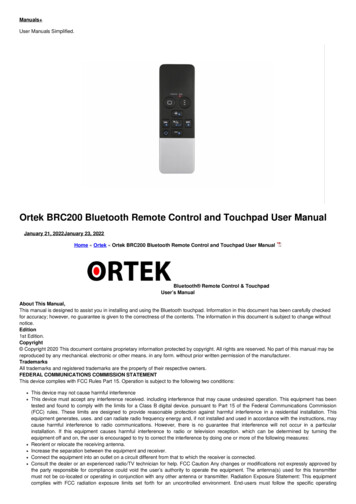
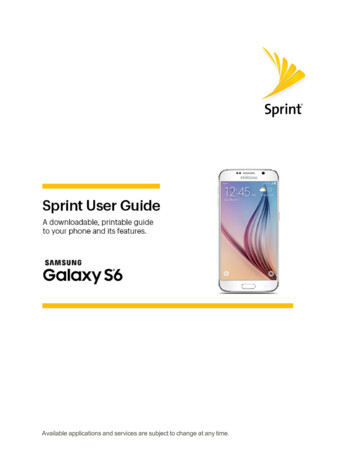

![[MS-CDP-Diff]: Connected Devices Platform Protocol Version 3](/img/35/5bms-cdp-5d-220429-diff.jpg)

